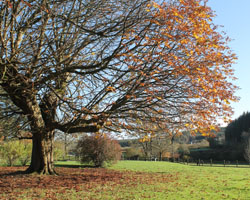
Touring Ireland
Galway
Galway, the "City of the Tribes," has been dubbed the "fastest growing city in Europe," and is home to some 50,000 people. It is a vibrant and young city, and because of this fact, there are countless things to do in Galway. The nightlife is excellent and tourism from Galway is unparallelled. Galway is a thriving cultural centre, evident in its many festivals, in its preservation of the Gaelic language, and its dedication to music and the arts.
Annual Festivals:
- The Galway Arts Festival, mid-July
- The Galway International Oyster Festival, late September
- The Galway Races, late-July/early-August
Westport
Westport, designated one of Bord Failte's Heritage Towns, is situated in the shadow of Croagh Patrick, overlooking Clew Bay. One of the few planned towns in the Country, Westport was designed in the 18th Century by James Wyatt. It has become one of Ireland's established tourism centres, with many outstanding features, most notably the beautiful tree lined boulevard known as The Mall, running parallel to the Carrowbeg River.
Croagh Patrick, one of Europe's best know places of Pilgrimage, has provided a tough ascent for many pilgrims each year, climbing barefoot in the memory of St. Patrick, who spent forty days and forty nights fasting on the summit more than 1,500 years ago. A small church at the summit of the mountain welcomes penitents, while magnificent views of Clew Bay, with an island for every day of the week, provides inspiration for many walkers and visitors throughout the year.
Sligo
With one of the greatest concentration of megalithic monuments in Ireland, Sligo boasts a landscape as rich in lore as it is in beauty . Sacked by the Vikings at the beginning of the ninth century, Sligo came to prominence once again in 1235, when the de Burgo invasion overthrew the local chieftains. The land was granted to Maurice Fitzgerald, Lord of Naas - who founded a castle and friary there in the years that followed. Now destroyed, the castle once stood on what is currently Castle Street. During the Great Famine, Sligo's population fell dramatically by a third through either death or emigration. By the end of the last century though, the town experienced a significant turn around, becoming a busy centre and hub of activity.The most celebrated of all of Ireland's poets, W.B Yeats was born in Dublin - his mother, however, was from Sligo, where he spent a lot of time as a child. Yeats visited Sligo frequently - periods which led to the inspiration of the poet in many of his future works, drawing spiritually from the county's scenic landscape and sense of place.
A litany of places and monuments pay homage to Yeats in the town of Sligo, and indeed in the areas surrounding it. At Drumcliffe, by the foot of Benbulben, where the poet is buried, a memorial stone complex has been built incorporating an audio-visual presentation about the poet, complimented with a craft and coffee shop. A sculptural portrayal of Yeats stands on Stephen Street, in Sligo town, inscribed with lines from the poets works, many relating to the 1916 Rising.
Clonmacnoise
Clonmacnoise (the Irish Cluain Mhic Nos) is an ancient ecclesiastical site, situated south of Athlone, near the centre of Ireland. Its location contributed to its development as a major centre of religion, learning, trade, craftsmanship and political influence. Clonmacnoise has a large collection of grave-slabs dating from the 8th to the 12th century, as well as one of Ireland's finest surviving High Crosses. In addition, the monastery contains many religious buildings.
The Boyne Valley
The valley encompasses legendary Tara, where High Kings ruled and heroes recalled their epic feats in battle, the Hill of Slane, where Patrick first lit the beacon of Christianity on the island, the mighty burial mounds of Newgrange, Knowth and Dowth - even older than the Pyramids, and Trim Castle, the largest Norman fortification to be established in the country. The Boyne Valley is unique in Ireland for the survival of ruins and relics from successive generations of civilisations through thousands of years. It was here that the glories of Celtic Ireland flourished, where Christianity first conquered and where the Catholic cause was finally lost with the defeat of King James II at the Battle of the Boyne in 1690. It rivers could speak, the Boyne could tell the complete story of Ireland's proud past!
Ulster American Folk Park
The Ulster American Folk Park is a museum of emigration and folklife telling the story of the floods of emigrants who left these shores. Exhibits include “Emigrants” indoor museum. Outdoor site has 26 buildings mostly original Irish thatched and American log structures.
Sail away to the new world on board the Brig Union life-sized emigrant sailing ship. Two complete streets on old and new world sites. Daily demonstrations include blacksmithing, spinning, printing and cookery. Costumed guides in exhibit buildings. A great day out!
Address: 2 Mellon Road, Omagh, Co. Tyrone
Tel: 028-8224 3292
The Giant's Causeway
The Giant’s Causeway is Northern Ireland’s most famous landmark and a World Heritage Site. It takes its name from the legends of Finn MacCool and is draws people from far and wide to this corner of north Antrim.
The north Antrim coastline in renowned for it scenic beauty and the Giant’s Causeway is its unique jewel in the crown, known to the Irish as the 8th Wonder of the World. A jagged promontory of neatly packed columns of hexagonal rocks created some 6 million years ago by a flow of basaltic lava. As the lava cooled it form these distinctive hexagonal shapes just as the bottom of a dried riverbed would crack into shapes.
It is easy to see how these almost perfectly symmetrical formations would be viewed as otherworldly by our earlier ancestors and how the Giant’s Causeway would give rise to colourful legend. The story goes that mythical Irish giant Finn MacCool built the causeway to get to Scotland and battle with a rival giant called Benandonner. When he got there he found that the Scottish giant was asleep but also far bigger than himself, so Finn returned back across the causeway. When Benandonner woke up he came across the causeway intent on fighting Finn. Finn’s wife dressed up her husband as a baby and when Benandonner arrived she said Finn wasn’t home and to be quiet not to wake up the baby. When Benandonner saw the ‘baby’ he decided that if the baby was that big, Finn must be massive. So he turned tail and fled back across the causeway ripping it up as he went. All that remains are the ends, here at the Giant’s Causeway and on the island of Staffa in Scotland where similar formations are found.
